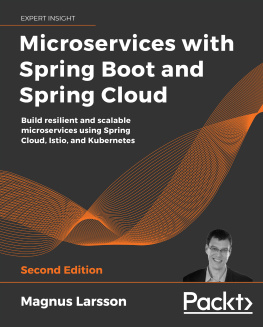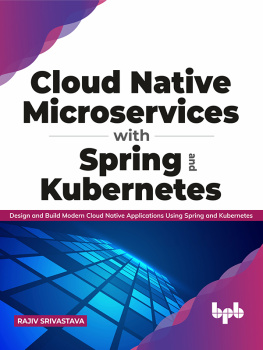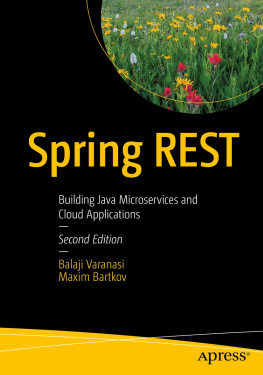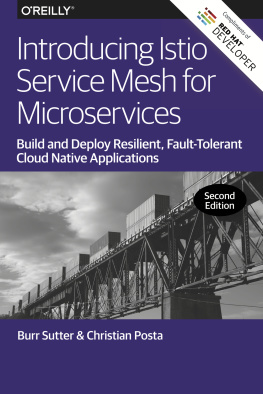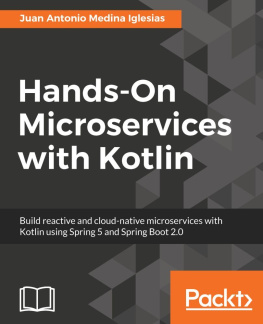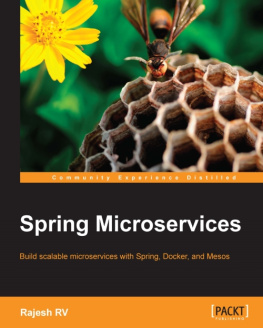Magnus Larsson - Microservices with Spring Boot and Spring Cloud - Second Edition: Build resilient and scalable microservices using Spring Cloud, Istio, and Kubernetes
Here you can read online Magnus Larsson - Microservices with Spring Boot and Spring Cloud - Second Edition: Build resilient and scalable microservices using Spring Cloud, Istio, and Kubernetes full text of the book (entire story) in english for free. Download pdf and epub, get meaning, cover and reviews about this ebook. year: 2021, publisher: Packt Publishing, genre: Home and family. Description of the work, (preface) as well as reviews are available. Best literature library LitArk.com created for fans of good reading and offers a wide selection of genres:
Romance novel
Science fiction
Adventure
Detective
Science
History
Home and family
Prose
Art
Politics
Computer
Non-fiction
Religion
Business
Children
Humor
Choose a favorite category and find really read worthwhile books. Enjoy immersion in the world of imagination, feel the emotions of the characters or learn something new for yourself, make an fascinating discovery.
- Book:Microservices with Spring Boot and Spring Cloud - Second Edition: Build resilient and scalable microservices using Spring Cloud, Istio, and Kubernetes
- Author:
- Publisher:Packt Publishing
- Genre:
- Year:2021
- Rating:5 / 5
- Favourites:Add to favourites
- Your mark:
Microservices with Spring Boot and Spring Cloud - Second Edition: Build resilient and scalable microservices using Spring Cloud, Istio, and Kubernetes: summary, description and annotation
We offer to read an annotation, description, summary or preface (depends on what the author of the book "Microservices with Spring Boot and Spring Cloud - Second Edition: Build resilient and scalable microservices using Spring Cloud, Istio, and Kubernetes" wrote himself). If you haven't found the necessary information about the book — write in the comments, we will try to find it.
A step-by-step guide to creating and deploying production-quality microservices-based applications
Key Features:
- Build cloud-native production-ready microservices with this comprehensively updated guide
- Understand the challenges of building large-scale microservice architectures
- Learn how to get the best out of Spring Cloud, Kubernetes, and Istio in combination
Book Description:
With this book, youll learn how to efficiently build and deploy microservices. This new edition has been updated for the most recent versions of Spring, Java, Kubernetes, and Istio, demonstrating faster and simpler handling of Spring Boot, local Kubernetes clusters, and Istio installation. The expanded scope includes native compilation of Spring-based microservices, support for Windows & Mac, and an introduction to Helm 3 for packaging and deployment. A revamped security chapter now follows the OAuth 2.1 specification and makes use of the newly launched Spring Authorization Server from the Spring team.
Starting with a set of simple cooperating microservices, youll add persistence and resilience, make your microservices reactive, and document their APIs using Swagger/OpenAPI.
Youll understand how fundamental design patterns are applied to add important functionality, such as service discovery with Netflix Eureka and edge servers with Spring Cloud Gateway. Youll learn how to deploy your microservices using Kubernetes and adopt Istio. Youll explore centralized log management using the Elasticsearch, Fluentd, and Kibana (EFK) stack and monitor microservices using Prometheus and Grafana.
By the end of this book, youll be confident in building microservices that are scalable and robust using Spring Boot and Spring Cloud.
What You Will Learn:
- Build reactive microservices using Spring Boot
- Develop resilient and scalable microservices using Spring Cloud
- Use OAuth 2.1/OIDC and Spring Security to protect public APIs
- Implement Docker to bridge the gap between development, testing, and production
- Deploy and manage microservices with Kubernetes
- Apply Istio for improved security, observability, and traffic management
- Write and run manual and automated microservice tests with JUnit, testcontainers, Gradle, and bash
Who this book is for:
This book is intended for Java and Spring developers and architects who want to learn how to build microservice landscapes from the ground up and deploy them either on-premises or in the cloud, using Kubernetes as a container orchestrator and Istio as a service mesh.
No familiarity with microservices architecture is required to get started with this book.
Magnus Larsson: author's other books
Who wrote Microservices with Spring Boot and Spring Cloud - Second Edition: Build resilient and scalable microservices using Spring Cloud, Istio, and Kubernetes? Find out the surname, the name of the author of the book and a list of all author's works by series.

